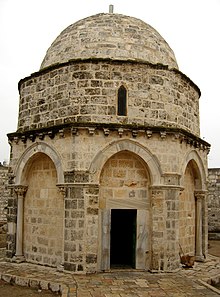Chapel of the Ascension (Jerusalem)
| Chapel of the Ascension | |
|---|---|

The Ascension Ædicule
|
|
| Basic information | |
| Location | Mount of Olives, Jerusalem |
| Affiliation | Christian, Islamic |
| District | At-Tur |
| Ecclesiastical or organizational status | Under Islamic Jurisdiction |
| Architectural description | |
| Architectural style | Romanesque |
| Completed | First church c390; current chapel: c1150 |
The Chapel of the Ascension (Hebrew: קפלת העלייה Kapelat ha-Aliyya, Greek: Εκκλησάκι της Αναλήψεως, Ekklisáki tis Analípseos) is a shrine located on the Mount of Olives, in the At-Tur district of Jerusalem. Part of a larger complex consisting first of a Christian church and monastery, then an Islamic mosque, it is located on a site the faithful traditionally believe to be the earthly spot where Jesus ascended into Heaven forty days after his resurrection. It houses a slab of stone believed to contain one of his footprints.
Shortly after the death and resurrection of Jesus, early Christians began gathering in secret to commemorate his Ascension at a small cave on the Mount of Olives. The issuance of the Edict of Milan by the Roman Emperor Constantine I in 313 made it possible for Christians to worship overtly without fear of government persecution. By the time of the pilgrim Egeria's travels to Jerusalem in 384, the spot of veneration had been moved to the present location, uphill from the cave.Saint Helena, mother of Constantine I, traveled to the holy land between 326 and 328. During her pilgrimage, she identified two spots on the Mount of Olives as being associated with Jesus' life. The place of his Ascension, and a grotto associated with his teaching of the Lord's Prayer. On her return to Rome she ordered the construction of two sanctuary complexes at these locations. According to legend, during the 5th century Saint Pelagia of Antioch lived here as a hermit and penitent in a grotto.
...
Wikipedia
